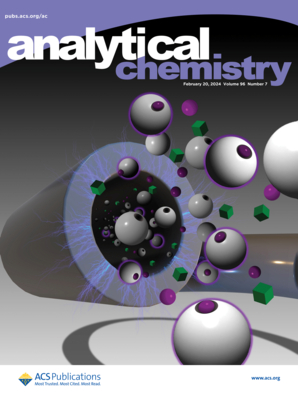Cascade Catalytic Iron Phosphate Nanozyme-Driven Signal Amplification in S-Scheme AgBr/La-BiOBr-OV for Sensitive Dual-Channel Microfluidic PEC Detection of CA15-3 and CA125.
IF 6.7
1区 化学
Q1 CHEMISTRY, ANALYTICAL
引用次数: 0
Abstract
An innovative dual-channel microfluidic photoelectrochemical (PEC) immunosensor was constructed for simultaneous determination of carbohydrate antigen 15-3 (CA15-3) and cancer antigen 125 (CA125). Herein, AgBr-sensitized La-doped BiOBr with surface oxygen vacancies (AgBr/La-BiOBr-OV) was synthesized as a photoactive material to provide a stable photocurrent. Constructing an S-scheme heterojunction with AgBr and BiOBr facilitates the effective separation of photogenerated carriers. Meanwhile, the introduction of La and oxygen vacancies extends the range of visible-light absorption and improves the light utilization. To strengthen the PEC performance, a cascade catalytic amplification strategy was introduced using iron-phosphate-based (FePOs) nanozymes. These nanozymes exhibit dual enzyme-mimicking activities, including catalase (CAT)-like and superoxide dismutase (SOD)-like functions, enabling the sequential disproportionation of •O2- into H2O2 and O2, followed by the decomposition of H2O2 into O2 and H2O. The generated oxygen acts as an efficient electron acceptor, promoting the removal of photogenerated electrons and consequently boosting the PEC response. Under optimized conditions, the developed immunosensor enables highly sensitive quantification of CA15-3 (0.0005-200 U/mL) and CA125 (0.001-200 U/mL), with corresponding limits of detection (LOD) of 0.00016 and 0.0003 U/mL, respectively. This study provides a promising approach to constructing efficient S-scheme photoactive heterostructures and offers new insights into nanozyme-based cascade amplification for high-performance PEC biosensing.级联催化磷酸铁纳米酶驱动的S-Scheme AgBr/La-BiOBr-OV信号放大用于敏感的双通道微流体PEC检测CA15-3和CA125。
构建了一种新型双通道微流控光电化学(PEC)免疫传感器,用于同时检测碳水化合物抗原15-3 (CA15-3)和癌症抗原125 (CA125)。本文合成了具有表面氧空位的AgBr敏化la掺杂BiOBr (AgBr/La-BiOBr-OV)作为光活性材料,以提供稳定的光电流。与AgBr和BiOBr构建S-scheme异质结有助于光生载流子的有效分离。同时,镧和氧空位的引入扩大了可见光吸收范围,提高了光利用率。为了提高PEC的性能,采用磷酸铁基(FePOs)纳米酶进行级联催化扩增。这些纳米酶具有双重酶模拟活性,包括过氧化氢酶(CAT)样和超氧化物歧化酶(SOD)样功能,使•O2-依次歧化为H2O2和O2,然后将H2O2分解为O2和H2O。生成的氧作为一个有效的电子受体,促进光生电子的去除,从而增强PEC响应。在优化条件下,所研制的免疫传感器对CA15-3 (0.0005-200 U/mL)和CA125 (0.001-200 U/mL)的定量具有高灵敏度,检出限(LOD)分别为0.00016和0.0003 U/mL。该研究为构建高效的s方案光活性异质结构提供了一种有前途的方法,并为基于纳米酶级联扩增的高性能PEC生物传感提供了新的见解。
本文章由计算机程序翻译,如有差异,请以英文原文为准。
求助全文
约1分钟内获得全文
求助全文
来源期刊

Analytical Chemistry
化学-分析化学
CiteScore
12.10
自引率
12.20%
发文量
1949
审稿时长
1.4 months
期刊介绍:
Analytical Chemistry, a peer-reviewed research journal, focuses on disseminating new and original knowledge across all branches of analytical chemistry. Fundamental articles may explore general principles of chemical measurement science and need not directly address existing or potential analytical methodology. They can be entirely theoretical or report experimental results. Contributions may cover various phases of analytical operations, including sampling, bioanalysis, electrochemistry, mass spectrometry, microscale and nanoscale systems, environmental analysis, separations, spectroscopy, chemical reactions and selectivity, instrumentation, imaging, surface analysis, and data processing. Papers discussing known analytical methods should present a significant, original application of the method, a notable improvement, or results on an important analyte.
 求助内容:
求助内容: 应助结果提醒方式:
应助结果提醒方式:


